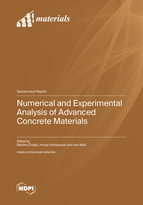Numerical and Experimental Analysis of Advanced Concrete Materials
A special issue of Materials (ISSN 1996-1944). This special issue belongs to the section "Construction and Building Materials".
Deadline for manuscript submissions: closed (10 June 2023) | Viewed by 21162
Special Issue Editors
Interests: structural analysis; structural dynamics; earthquake engineering; finite and discrete element modeling; numerical analysis; civil engineering materials
Interests: concrete; numerical simulation
Special Issues, Collections and Topics in MDPI journals
Interests: civil engineering; stability of structures; earthquake engineering; numerical modelling of structures
Special Issues, Collections and Topics in MDPI journals
Special Issue Information
Dear Colleagues,
In modern engineering practice, different types of concrete structures are used. Current applications in the construction of modern structures, or applications in the strengthening and reinforcement of existing structures, require the analysis of structures with different material properties and shapes exposed to different types of loads, such as quasi-static, dynamic, cyclic, impact, or seismic.
Advanced concrete structures, whether developed as new structures or reinforced existing structures, should satisfy a range of structural functions during operation conditions.
In practice, there are several experimental tests that provide new insights into concrete as a material at the micro, mezzo, and macro levels. The results significantly increase knowledge about the behavior of concrete as a material. Such tests are expensive, but their significance lies in the possibility of implementing material behavior in new numerical models. The development of new numerical models, if based on the results of experiments, can simulate the behavior of concrete as a building material with improved properties due to a new type of aggregate, some chemical composition, etc. Numerical models can also simulate the behavior of concrete structures whose load capacity can be an increased form of fastening.
The aim of this Special Issue is to collect and present experimental results as well as new numerical simulations of the behavior of concrete as a material and concrete structures, thus, providing a better understanding of the basic principles of cracking and crack propagation in concrete structures exposed to different types of loads. A thorough understanding, whose processes affect the reduction of strength and the formation of cracks in concrete, is key to the analysis of existing materials and the design of improved innovative materials of concrete and concrete structures.
Dr. Nikolina Živaljić
Dr. Hrvoje Smoljanović
Dr. Ivan Balić
Guest Editors
Manuscript Submission Information
Manuscripts should be submitted online at www.mdpi.com by registering and logging in to this website. Once you are registered, click here to go to the submission form. Manuscripts can be submitted until the deadline. All submissions that pass pre-check are peer-reviewed. Accepted papers will be published continuously in the journal (as soon as accepted) and will be listed together on the special issue website. Research articles, review articles as well as short communications are invited. For planned papers, a title and short abstract (about 100 words) can be sent to the Editorial Office for announcement on this website.
Submitted manuscripts should not have been published previously, nor be under consideration for publication elsewhere (except conference proceedings papers). All manuscripts are thoroughly refereed through a single-blind peer-review process. A guide for authors and other relevant information for submission of manuscripts is available on the Instructions for Authors page. Materials is an international peer-reviewed open access semimonthly journal published by MDPI.
Please visit the Instructions for Authors page before submitting a manuscript. The Article Processing Charge (APC) for publication in this open access journal is 2600 CHF (Swiss Francs). Submitted papers should be well formatted and use good English. Authors may use MDPI's English editing service prior to publication or during author revisions.
Keywords
- concrete materials
- concrete structures
- quasi-static, dynamic, cyclic loading
- impact load
- concrete cracking
- damage and fracture processes
- numerical analysis and simulation
- experimental analysis and simulation









